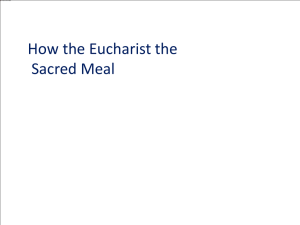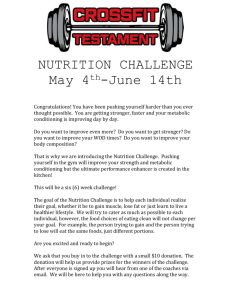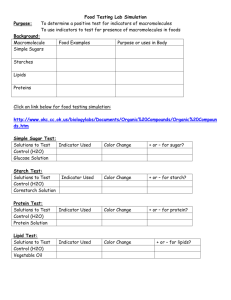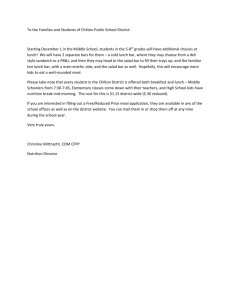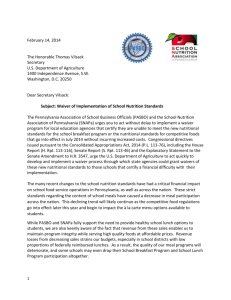AMacromoleculesLab12
advertisement
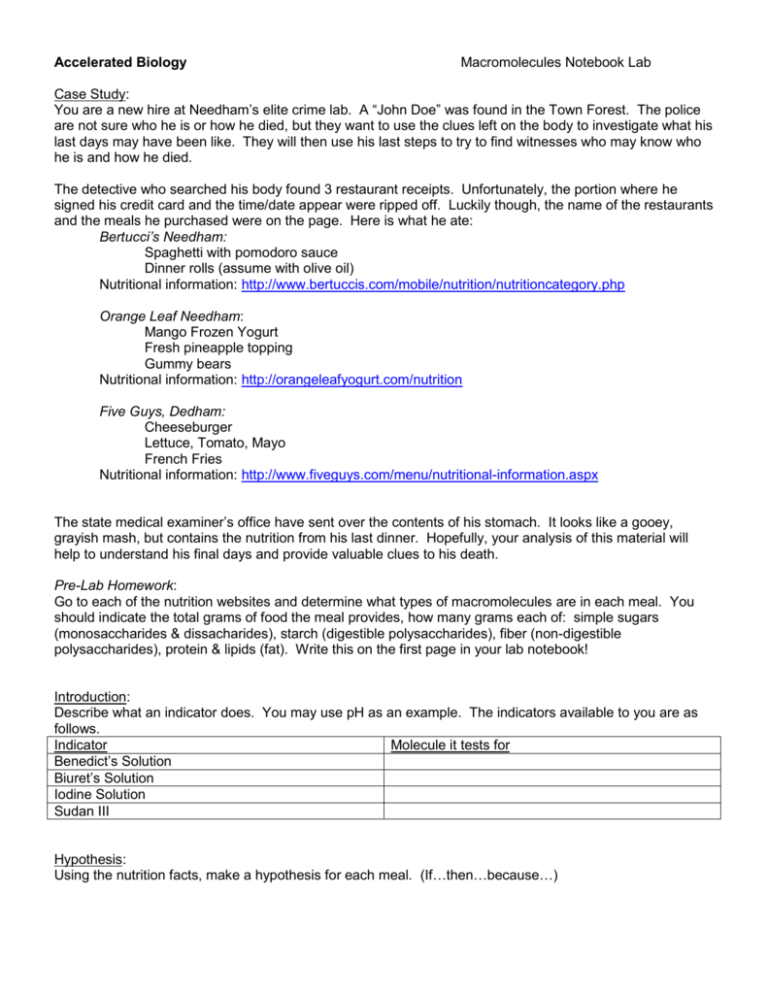
Accelerated Biology Macromolecules Notebook Lab Case Study: You are a new hire at Needham’s elite crime lab. A “John Doe” was found in the Town Forest. The police are not sure who he is or how he died, but they want to use the clues left on the body to investigate what his last days may have been like. They will then use his last steps to try to find witnesses who may know who he is and how he died. The detective who searched his body found 3 restaurant receipts. Unfortunately, the portion where he signed his credit card and the time/date appear were ripped off. Luckily though, the name of the restaurants and the meals he purchased were on the page. Here is what he ate: Bertucci’s Needham: Spaghetti with pomodoro sauce Dinner rolls (assume with olive oil) Nutritional information: http://www.bertuccis.com/mobile/nutrition/nutritioncategory.php Orange Leaf Needham: Mango Frozen Yogurt Fresh pineapple topping Gummy bears Nutritional information: http://orangeleafyogurt.com/nutrition Five Guys, Dedham: Cheeseburger Lettuce, Tomato, Mayo French Fries Nutritional information: http://www.fiveguys.com/menu/nutritional-information.aspx The state medical examiner’s office have sent over the contents of his stomach. It looks like a gooey, grayish mash, but contains the nutrition from his last dinner. Hopefully, your analysis of this material will help to understand his final days and provide valuable clues to his death. Pre-Lab Homework: Go to each of the nutrition websites and determine what types of macromolecules are in each meal. You should indicate the total grams of food the meal provides, how many grams each of: simple sugars (monosaccharides & dissacharides), starch (digestible polysaccharides), fiber (non-digestible polysaccharides), protein & lipids (fat). Write this on the first page in your lab notebook! Introduction: Describe what an indicator does. You may use pH as an example. The indicators available to you are as follows. Indicator Molecule it tests for Benedict’s Solution Biuret’s Solution Iodine Solution Sudan III Hypothesis: Using the nutrition facts, make a hypothesis for each meal. (If…then…because…) Methods: Choose one of the indicators and describe how the indicator was used to test for the substance. Follow the directions at each lab station to test your sample, the positive control substance (provided at the station), and the negative control substance (provided at the station). Be sure to test your sample with all four tests! Even if you don’t think it will have a certain macromolecule, you need to confirm this using your tests! Data and Analysis: Graph: Calculate the total grams/serving for each meal. Then calculate the % of the diet made up of (simple sugars, polysaccharides (separate fiber and starch), proteins, lipids) For each of the meals, make a pie chart showing the total % of each type of molecule. Controls Table: Indicator Positive Control Substance Positive Control Result Negative Control Substance Negative Control Result Benedict’s Biuret’s Iodine Sudan III Sample Table: (Use the results from your control to analyze the results) Sample Test Color Change Analysis Make a written trend to identify the key results of the experiment. What was the last meal that the John Doe ate based on the information from the nutrition facts compared with the analysis of the stomach contents. Conclusions: Accept or reject each of the hypotheses using your data. Draw a conclusion based on the available data about where the victim ate his last meal and explain the reason for your conclusion. Discuss in general sources of each of the macromolecules that the indicator test for. Research and explain what a balanced meal should have for: sugars, starch, fiber, fats, protein. Were any of the meals our victim ate balanced? Suggest a well-balanced meal. Error: a) Why is it important to run positive and negative controls when using indicators? b) Describe the terms “false positive” and “false negative”. See if you can identify any examples in your data. (If not, explain what an example of each would be and why these might show up in a test. c) Is this test qualitative or quantitative? What are the limitations of this test? How might this be a source of error?


